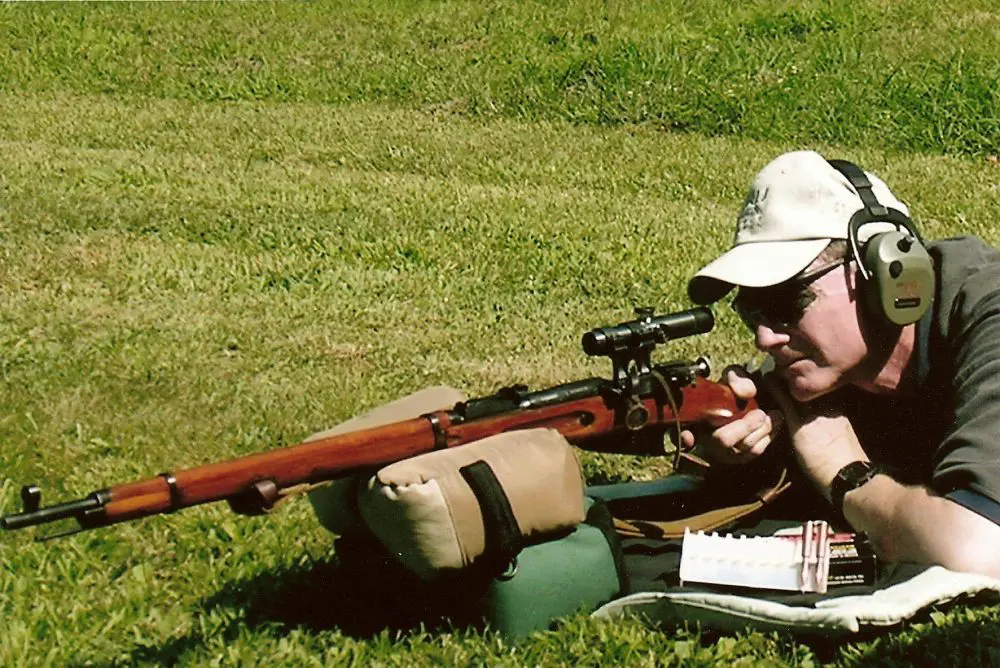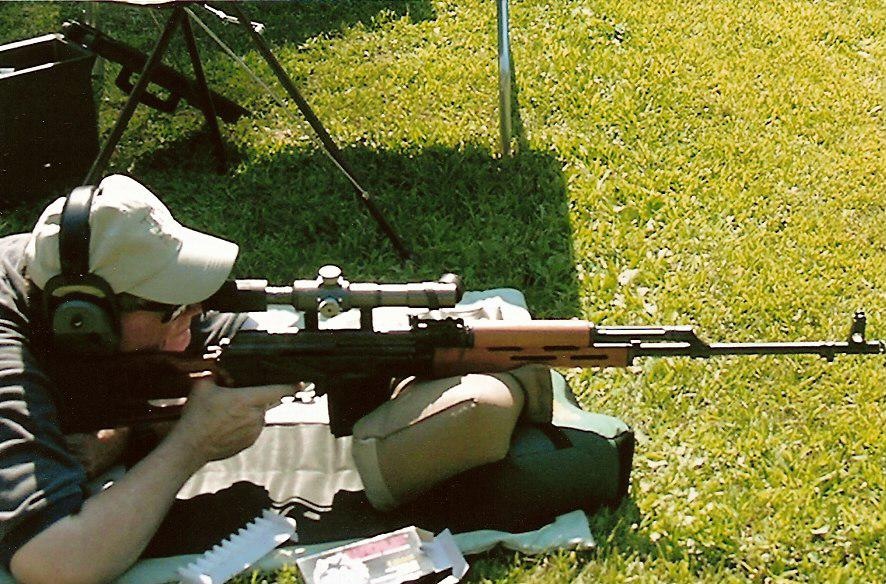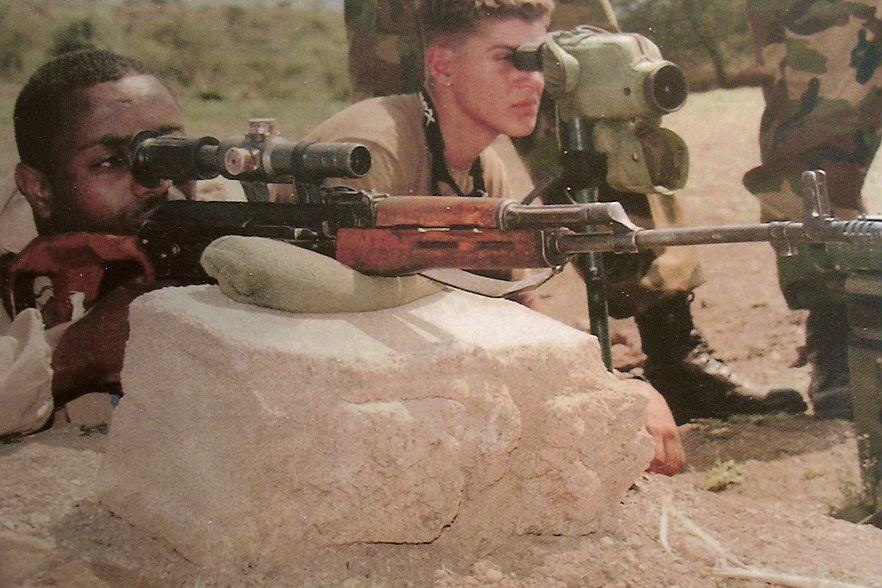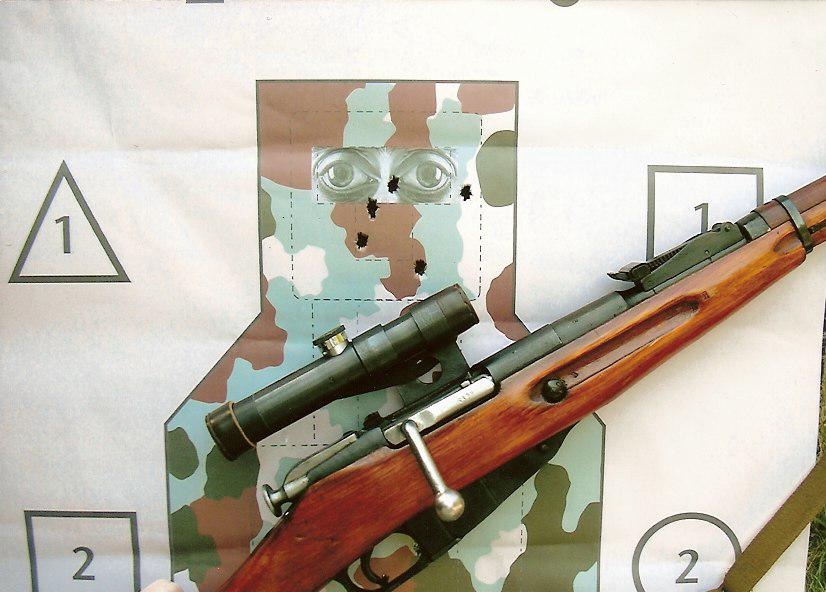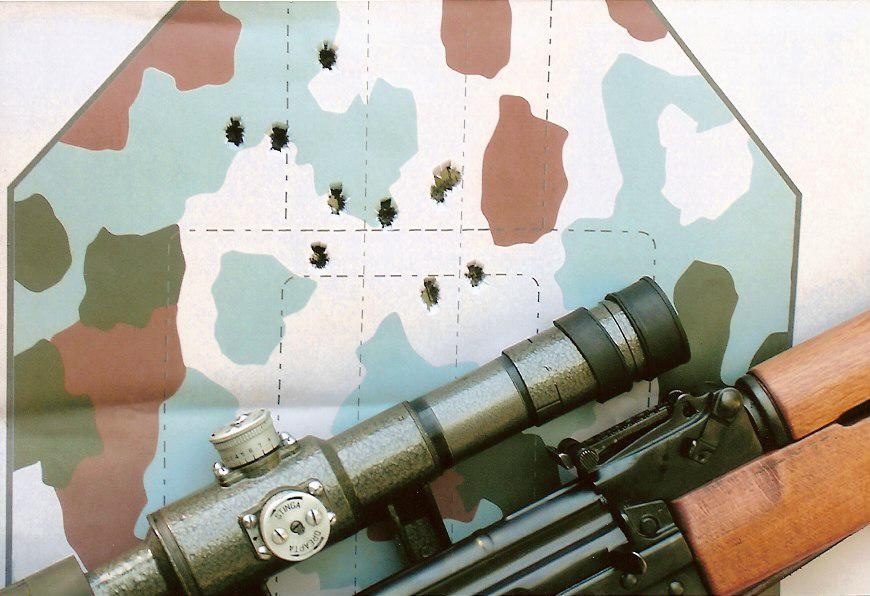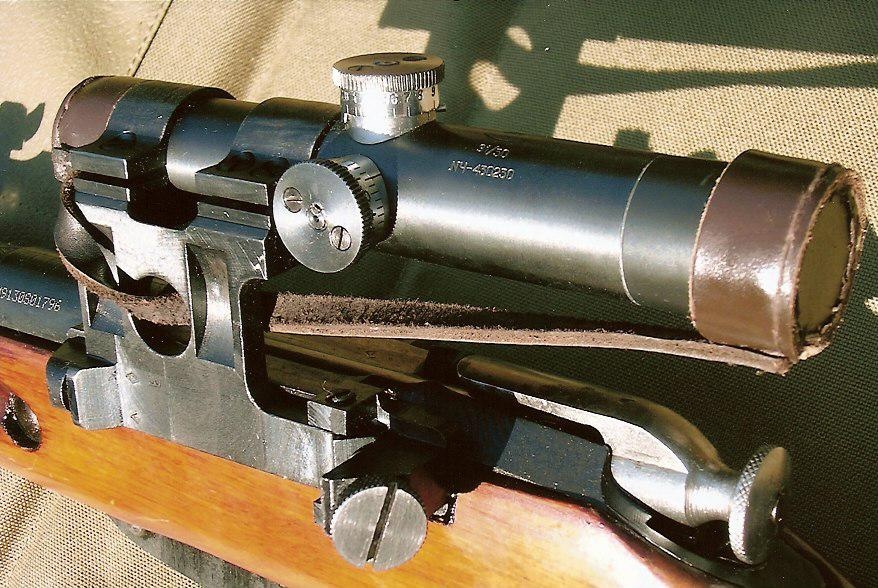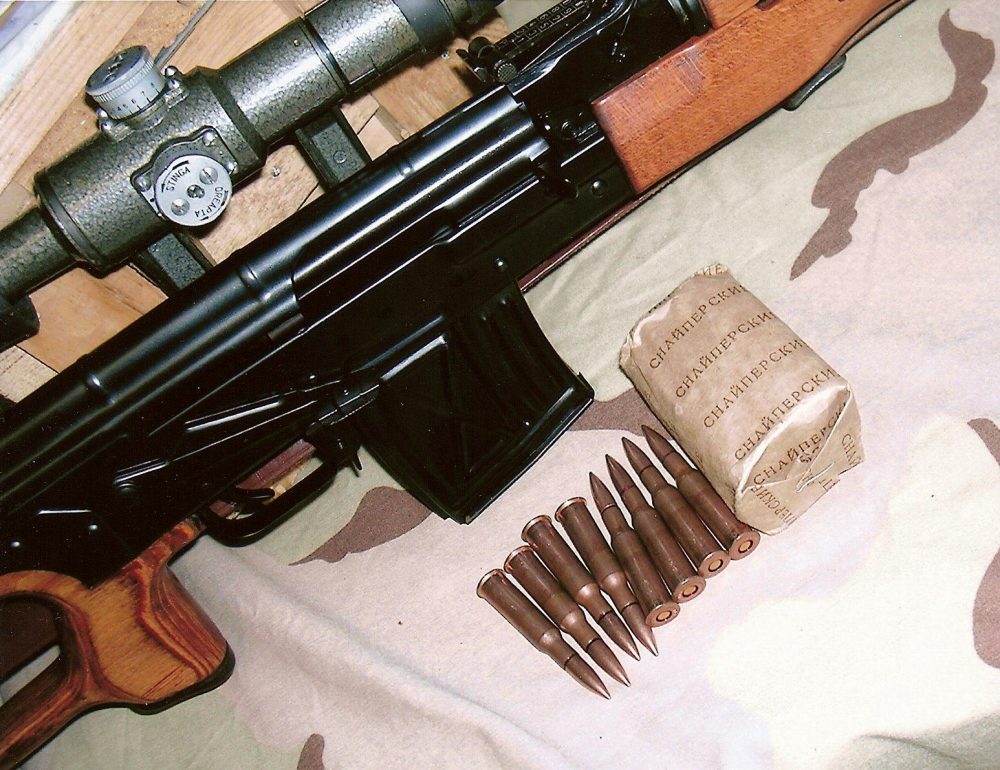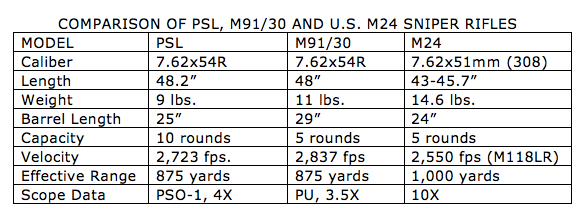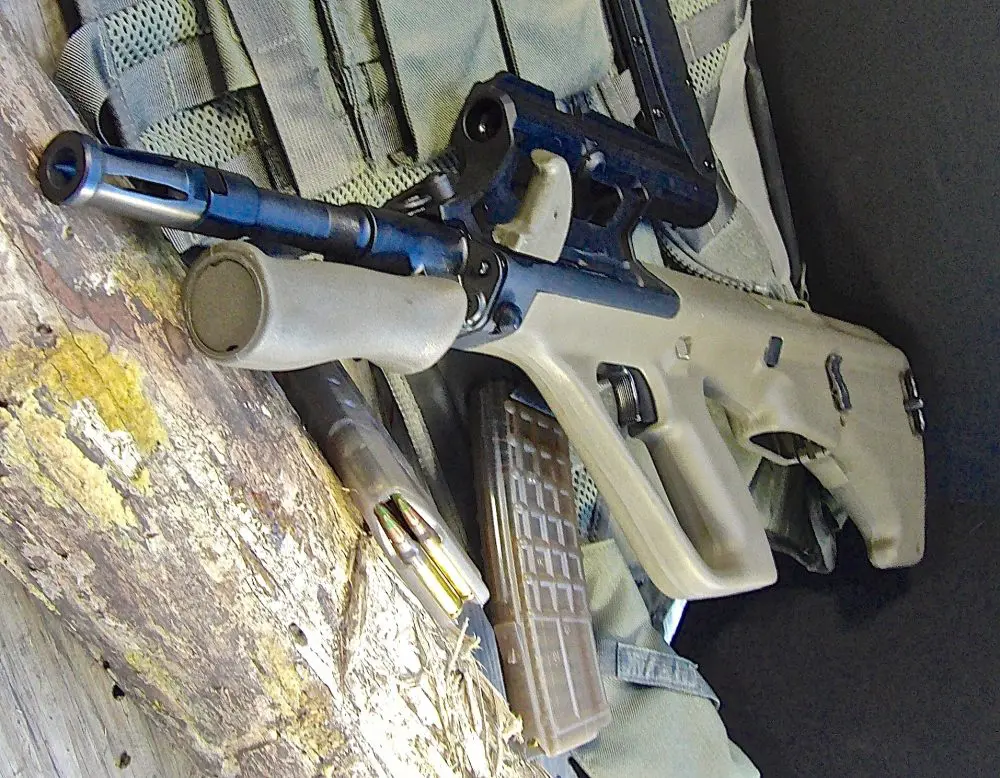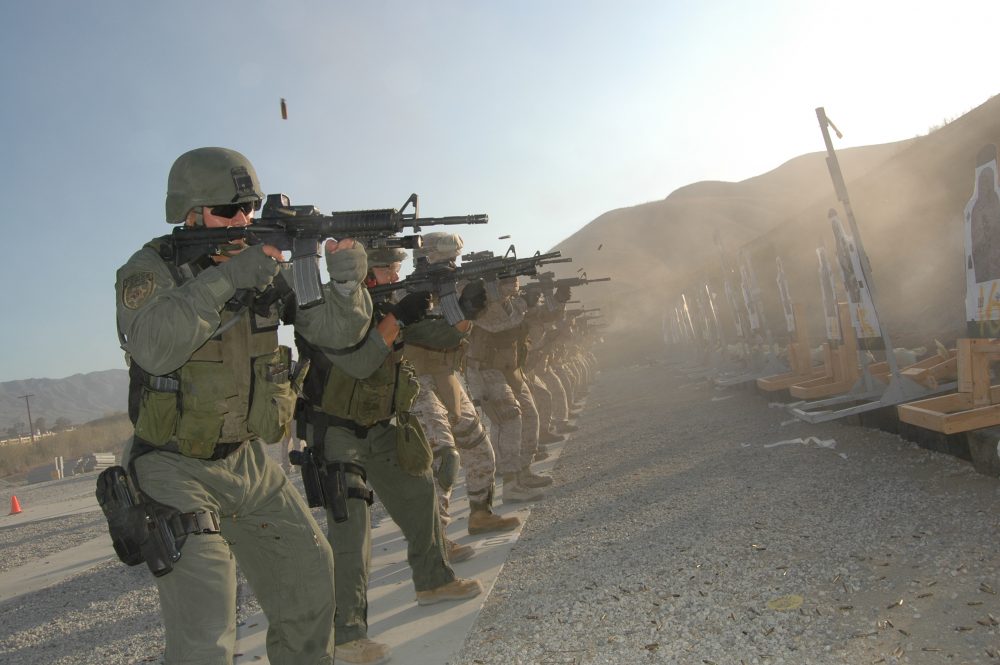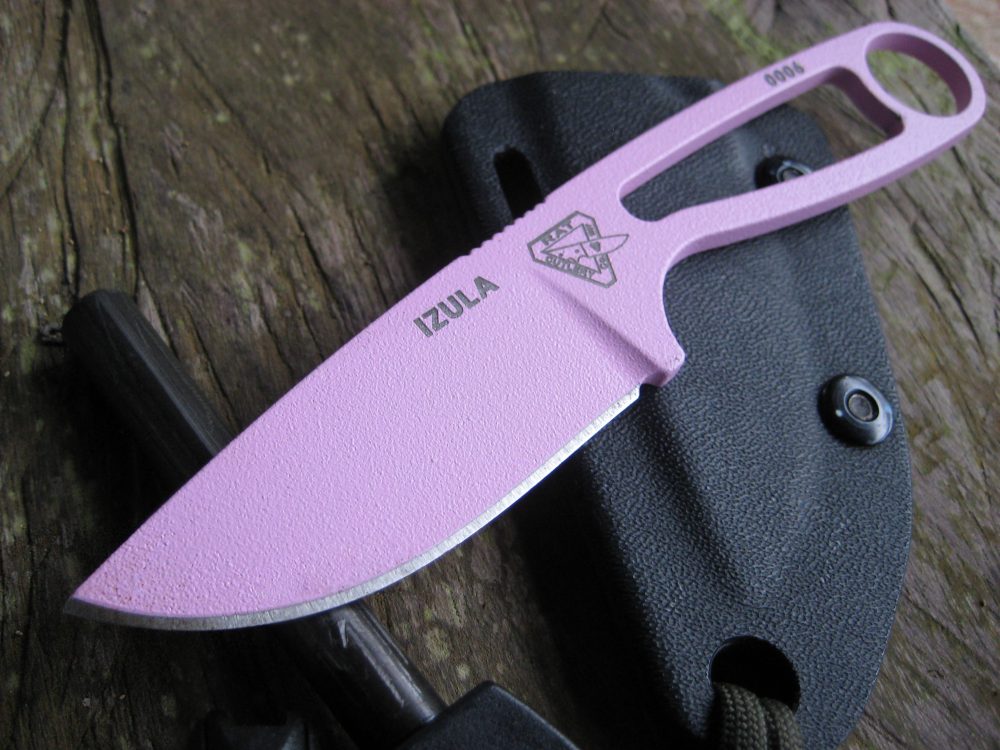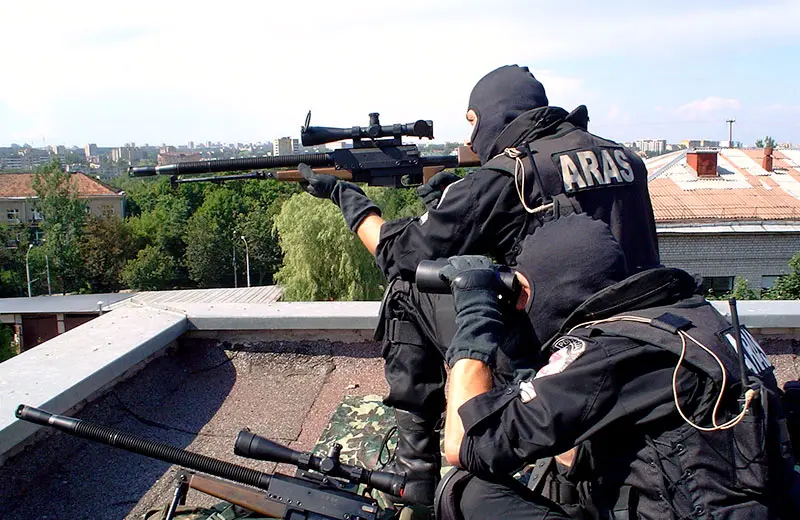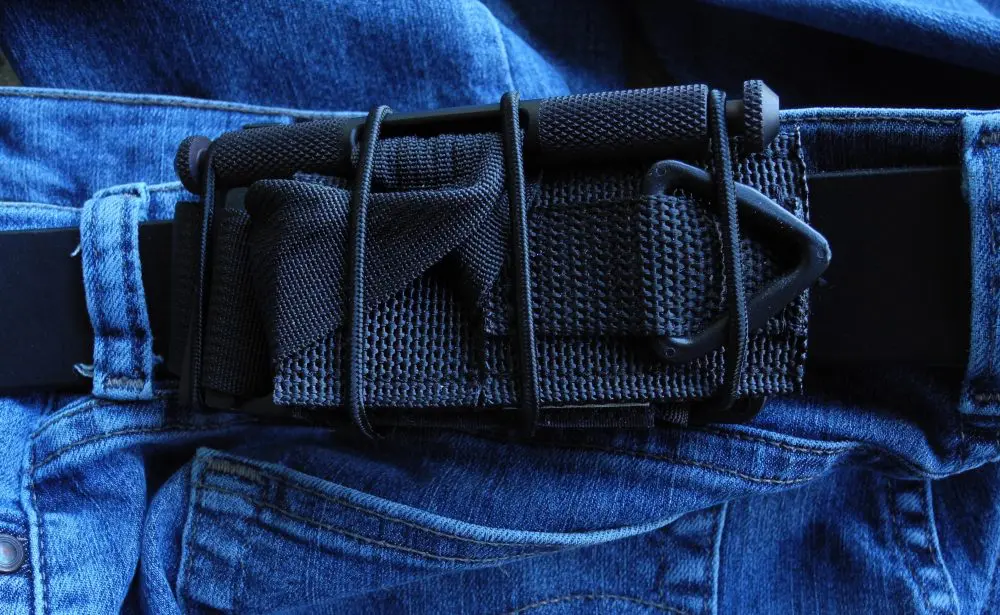Watching TV footage from Iraq and Afghanistan, you are led to believe that “Haji the terrorist” has an interesting concept of the basic fundamentals of rifle marksmanship. We see insurgents firing their AK-47s with one or two hands, waving the weapon casually in the direction of coalition forces and firing full automatic. Other pictures show the same shooters behind walls holding the gun up and over and spraying fire in the general direction of where they think their targets are. Improvised Explosive Devices (IEDs) that are remotely detonated close to concentrations of troops or vehicles are causing most coalition forces casualties.
Author firing M91/30 with PU scope.
I was surprised when I received a briefing from a friend who was just returning from his third time around in both Iraq and Afghanistan, about coalition forces casualties that are being sustained as a result of accurate, long-range enemy rifle fire. Sniper weapons were being recovered after engagements and medical units were treating more soldiers for upper torso and head wounds. Conclusions reached by intelligence units after the capture of sniping weapons and several enemy snipers pointed to an increasing number of terrorists who do know how to shoot at longer ranges with rifles that are capable of inflicting wounds with accuracy to 800 meters.
The identity of the snipers was not surprising. Many were foreign nationals from Iran, Saudi Arabia, Syria and Chechnyan rebels who apparently have honed their skills fighting against Russian forces in their homeland.
Since most readers are familiar with the former Soviet Union and its satellites’ support for many Arab regimes in the Middle East, it will be no surprise that all of the weapons recovered and identified to this writer by my source were former Communist bloc weapons. In Afghanistan, which had a government supported by the Soviet Union before it invaded to try and save that government, numerous Soviet sniping weapons were captured and used against Soviet forces by the mujahideen—and later the Taliban against coalition troops. I was able to obtain samples of two weapons recovered with some degree of frequency in both Iraq and Afghanistan for a field test to examine what their long-range capabilities really are.
Author firing Romanian PSL from 300 yards.
Table of Contents
MOSIN-NAGANT SNIPER RIFLE
The Mosin-Nagant Model 91/30 7.62x54R sniper rifle was the most widely produced and issued sniper rifle of WWII. According to Soviet records, close to 200,000 of these scope-equipped rifles were manufactured, beginning in 1932 and ending in 1947. Because of the large numbers produced, along with recent production ersatz sniper rifles assembled in Russia and former Soviet bloc countries for importation to this country, this rifle is very familiar to firearm enthusiasts.
The general public was introduced to the 91/30 Mosin-Nagant in the 2001 movie Enemy at the Gates, a Hollywood version of the supposed duel between Soviet sniping hero Vasiliy Zaitsev and Major Koenig, commander of the Wehrmacht sniping school, in the ruins of Stalingrad. While the duel has never been verified and both Soviet and German military records make no mention of it, the movie propagated the legend and was technically correct in terms of weapons.
U.S. Army Special Forces soldier instructing Ethiopian Army soldier with PSL. PSL is most frequently recovered sniper rifle in Iraq.
The Mosin-Nagant 91/30 sniper rifle is based on an 1891 bolt-action design developed by a Russian Army officer (Mosin) and a Belgian (Nagant) in response to a request by the Russian Czar to improve the weaponry of the Russian Imperial Army. The simple bolt-action, magazine-fed rifle resembles many rifles of the period: full length wood stock, long barrel (30 inches), and firing a rimmed .30 cal cartridge. The 7.62x54R (rimmed) round is very similar in performance to our 7.62×51 (.308) loading and today, at 115 years of age, represents the longest serving military rifle round in the world. After the Russian Revolution, a modernization program for the Model 1891 rifle was initiated and culminated in a modified rifle designated the M91/30.
The M91/30 has been equipped with two scopes. The first is a four-power model ironically produced by Zeiss Optics in Germany and then later at a German-built plant in the Soviet Union. The second and most common telescopic sight used is a Soviet design designated the PU. This short 3.5-power scope was shown in Enemy at the Gates and is most frequently seen on rifles imported into the U.S. Since it was the primary telescopic sight for Soviet WWII weapons, the M91/30 rifles recovered in Iraq and Afghanistan are found with this scope.
Five-shot group fired at 300 yards with M91/30 rifle with PU scope.
ROMANIAN PSL 7.62X54R SNIPER RIFLE
During WWII, the Soviet Union experimented with semiautomatic rifles for use in sniping, first with the SVT38 and later with the SVT40 rifles, both in 7.62x54R. Neither rifle functioned reliably in the harsh conditions of the Soviet climate, but their use gave rise to the development of another semiautomatic rifle, this time specifically designed for the sniping role. The Snayperskaya Vintovka Dragunova (SVD) rifle was introduced into the Soviet military sometime in early 1963, according to best guesses. Again using the venerable 7.62x54R round with a very advanced telescopic sighting system—the b PSO-1 scope—the Dragunov, as the SVD is popularly known, gained notice during the Soviet invasion of Afghanistan.
The “Drag” resembles the AK-47 in design, but differs internally, has a milled steel receiver, a refined trigger mechanism, 24.5-inch barrel, a ten-round magazine, purpose-designed stock and was designed to optimize the accuracy of the 7.62×54 round to 800 meters, according to Soviet sniping doctrine of the time. Tests by the U.S. military and review of Soviet technical bulletins indicate that Drags were required to hold a 14.7-inch group with ball ammunition at 600 meters (656 yards). Interestingly, the NATO standard for sniper rifles at 600 meters is 15 inches.
The SVD, however, required some complex internal parts and a milled steel receiver. Consequently, many of the Soviet satellites with their own weapons production capability wanted Dragunov performance but with a simpler and cheaper to manufacture weapons system. One Soviet satellite, Romania, elected to use Mikhail Kalashnikov’s RPK light machine gun design and modify it to give it SVD performance. Called the Puska Semiautomata Luneta (Scoped Semiautomatic Rifle), the PSL was widely exported and is found in use by terrorist forces in Iraq and Afghanistan. Cases of unissued PSLs along with their modified PSO-1 scope sights have been recovered by U.S. forces throughout Iraq. We obtained a virtually unused, imported rifle for our tests.
PSL was capable of this ten-shot rapid-fire group from 300 yards.
ACCURACY SPECIFICATIONS FOR THE PSL AND M91/30 WITH PU SCOPE
While neither of these rifles has the refined look that shooters have come to expect with modern, specially manufactured sniper rifle systems such as the M24 and M40A3, within the parameters of Soviet sniping doctrine (accurate engagement of multiple high profile targets at 600 meters to a maximum of 800 meters), both the PSL and M91/30 were capable of satisfying Soviet doctrinal requirements. Technical information obtained on both the M91/30 with PU scope and PSL with modified PSO-1 scope reveals surprising accuracy requirements for “unrefined” rifles using very basic telescopic sights and issue ball ammunition.
According to Soviet sniper rifle requirement documents, the M91/30 with PU scope using 7.62x54R ball ammunition (M1930 Type L with 148 gr. FMJ bullet) was expected to produce:
- ten shots into 3.5cm (1.38”) at 100 meters
- ten shots into 7.5cm (2.96”) at 200 meters
- ten shots into 18 cm (7.09”) at 400 meters
- ten shots into 35 cm (13.79”) at 600 meters
While no doubt shot from some sort of mechanical rest, this is a very difficult accuracy standard considering these were not specially built (records indicate that rifles were selected for accuracy during acceptance testing), used a 3.5 power, awkwardly placed telescopic sight and ball ammunition produced in a very difficult manufacturing environment. Only the British Mk4 No.1T came anywhere close to matching the performance of the M91/30.
The PSL accuracy requirements are somewhat vague, due to the lack of verifiable Romanian military accuracy requirement documents. But since the PSL uses an identical four power telescopic sight manufactured by the excellent optics works IOR with the same range-finding reticle of the Soviet PSO-1, and the same type of ammunition, it is reasonable to expect that the rifle would perform to the same accuracy standards as the SVD Dragunov. Soviet military training manuals require the SVD Dragunov to place four shots within an 8cm circle (approximately 3 inches) at 100 meters when fired by a trained marksman using a prone sandbag rest. Other documents show much more stringent accuracy requirements for the rifle, listing 5.4 cm groupings at 300 meters for four shots, and the 600-meter requirement of 14.7” at 600 meters (656 yards).
M91/30 3.5 PU scope and mount—crude but effective.
7.62X54R AMMUNITION
The 7.62x54R cartridge was adopted by the Imperial Russian Army in 1891 and has been doing a good job of killing people for over 115 years—longer than any other military service rifle cartridge.
The original round as fielded in 1891 contained a 210-gr. round-nosed FMJ projectile. The experiences in the Russo-Japanese War of 1904-1905 (all bad for the Russians) convinced the Imperial Army that a more efficient projectile design—similar to the 7mm Mauser—that gave better long-range ballistic performance was needed. In 1908 a new “light” bullet load with a 148-gr. Spitzer FMJ was adopted and remained essentially the standard loading for the 7.62x54R to date. Loaded to a velocity of approx. 2,700 feet-per-second (fps), the 7.62x54R ballistically very closely resembles the M80 ball 7.62mm NATO round. Over the years the Soviets and their satellites experimented with heavier weight bullets for long-range machine gun fire, and different bullet construction for armor piercing and tracer use, but the 148-gr. has remained the standard loading weight.
With the fielding of the SVD Dragunov rifle in 1963, the Soviet Army realized that the accuracy potential of the rifle would only be reached with a refined loading of the 7.62x54R. Unlike the United States, which used existing match grade ammunition for sniping use (M118 and M72), the Soviets developed a specific loading for use in the SVD and also in the M91/30, which was still in use by satellites and third world armies supported by the Soviet Union. Designated the 7N1, this cartridge reportedly increases accuracy by at least two-fold over the standard Soviet ball round. Using a 152-gr. FMJ-BT bullet and extruded as opposed to ball propellant, this round has a unique bullet design that enhances both accuracy and terminal ballistic performance. Velocity from the SVD is reported to be 2,723 fps., which is similar to the standard 148 gr. ball loading and would allow emergency use of the ball round without a dramatic change to on target point of impact. We obtained a small quantity of this ammunition and used it in our tests, along with commercial Wolf ammunition loaded with the standard 148-gr. FMJBT.
More recently, the new Russian military has fielded a sniper loading that also has an armor piercing capability while retaining increased accuracy at long ranges. Designed for use in the newly fielded Soviet bolt-action sniper rifle—the SV-98—using a specially constructed 147-gr. FMJ-BT, this ammunition is reported to produce 1 MOA accuracy to long ranges and significant penetration capability through armor plate. We were unable to obtain any samples for our test.
Romanian PSL with PSO-type scope and Russian 7N1 sniper ammunition.
OUR TEST
The two Soviet-era rifles used for our test consisted of a 1943 manufactured M91/30 rifle with PU scope, made at the Izhevsk arsenal. M91/30s were produced at the two main Soviet small arms manufacturing centers, the other being the well-known Tula arsenal. Our PSL was a Romanian-produced recent import that had been examined and verified as technically correct for comparison to the PSLs being recovered in Iraq by noted AK gunsmith Mark Krebs of Krebs Customs, Inc. The M91/30 had a superb bore for a rifle of its vintage and the optics were clear, with the scope perhaps being of post-WWII manufacture. The only hindrance to shooting this rifle was the ungodly 12-pound-plus trigger pull and the scope height, which required a “chin” weld to see through!
The PSL was nearly as difficult to work with its stock configuration, but had a much, much better trigger pull. When multiple shots were fired, both rifles’ accuracy suffered as their thin barrels heated up, but in most sniping engagements, more than one shot is a rarity before things get hot for the sniper.
Romanian PSL with PSO-type scope and Russian 7N1 sniper ammunition.
CONCLUSION
While crude in comparison to the M24, M40A3 or a Designated Marksman M4/M16, both of our test rifles were fully capable of head shots on man-sized targets beyond the 300-yard range available for our tests. With the Russian 7N1 sniping ammunition, both rifles were capable of shooting 1 MOA out to realistic engagement distances. The hindrances to actually doing that were the low power of both rifles’ scopes, both rifles’ thin and easily overheated barrels, poor stock configurations and, in the case of the M91/30, a horrible trigger pull.
In the hands of a competent marksman, either of these rifles represents a significant threat to our troops’ safety, and unfortunately this is being seen increasingly in combat.
[The author would like to thank the following individuals for their help with this article:
CW4 John Miller, ARNG, Ret’d. One of the last of the old Army Ordnance Corps small arms armorers.
Mark Krebs of Krebs Custom, Inc. Mark is the acknowledged master builder of AK weapons systems rifles and carbines.]
